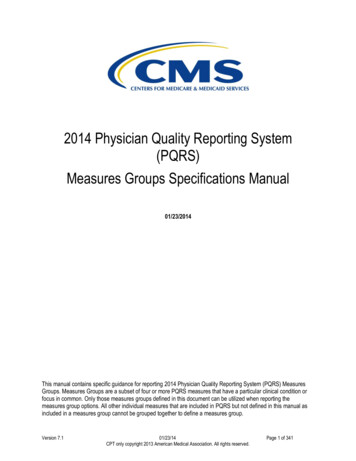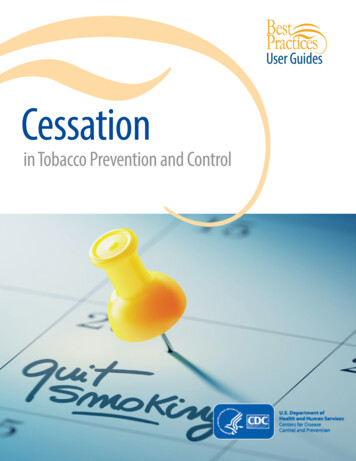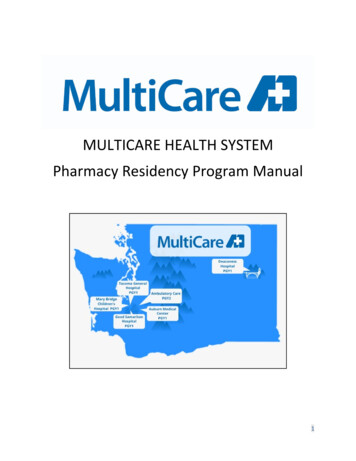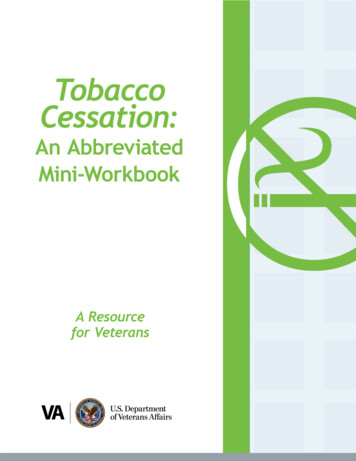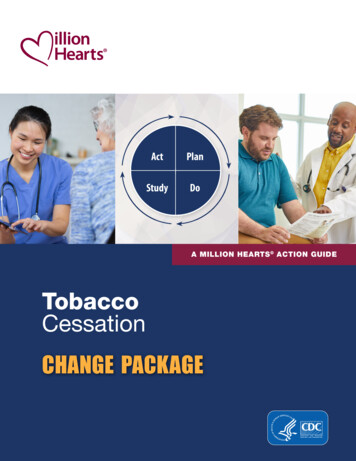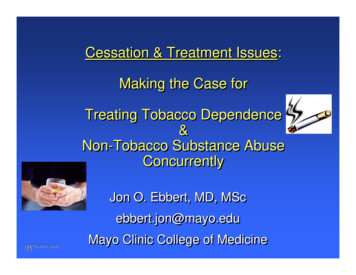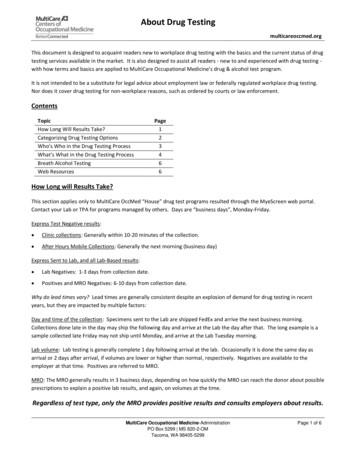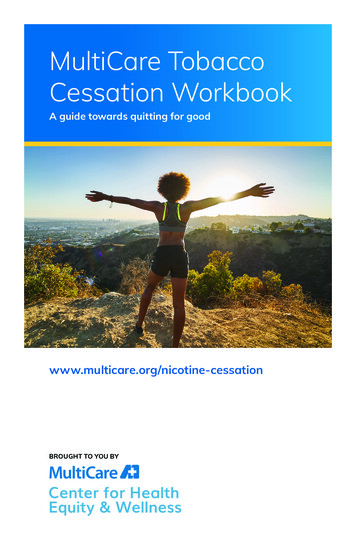
Transcription
MultiCare TobaccoCessation WorkbookA guide towards quitting for goodwww.multicare.org/nicotine-cessationBROUGHT TO YOU BY
Are you willing to make a quit attempt?MonthYearIf you are a current smoker, please answer these simple questionsto help understand your willingness to quit smoking.If I could quit smoking I would.Completely Disagree Somewhat disagree Neutral Somewhat agree Completely agreeI want to quit smoking because I worry about how smoking affectsmy healthCompletely Disagree Somewhat disagree Neutral Somewhat agree Completely agreeI would be willing to make a plan to quit smoking.Completely Disagree Somewhat disagree Neutral Somewhat agree Completely agreeI would be willing to cut down my number of cigarettes before quitting.Completely Disagree Somewhat disagree Neutral Somewhat agree Completely agreeNOTE: This tool is not validated. It is intended to provide directional guidance to help assess a patient’s willingness to make a quit attempt.
MultiCare NicotineCessation ntroduction. 2Things To Consider Before Your Quit Date. 3Why Do I Use Nicotine Products?. 4What’s Stopping Me?. 5Nicotine is Linked To Other Habits. 6Re-learn Nicotine Dependence. 10Treat Your Symptoms. 11How Tobacco Affects Your Body. 12Second Hand Smoke. 14The Benefits Of Quitting Can Begin In Minutes. 15Quit Medications Can Improve Your Chance Of Success. 16Getting Ready For Your Quit Day. 21Make A Clean Sweep. 22Create Your Own Personal Quit Kit. 24Practice Substituting New Healthy Behaviors. 25Stress Happens. 26Cravings For Nicotine – What Can I Do?. 27Get By With A Little Help From Your Friends. 28My Quit Day!. 29Exercise. 30Quitting Nicotine Without Weight Gain. 31Restore Your Body Through Good Nutrition – Food As Medicine. 32Quitting Methods That Work For Women. 33Slip Prevention. 34Celebrate. 35MultiCare Nicotine Cessation Workbook1
IntroductionNicotine cessation is one of the best things you can do to increase yourquality of life! We welcome you on this journey to a healthier and longer life.Every try counts – so don’t give up! It may take 6-8 attempts to quit forlasting success. Think of becoming nicotine-free as a chronic diseasethat you will work at, like managing high blood pressure or other healthconditions.What is the best way to quit? The BEST way to end nicotine dependenceis to use behavioral techniques to help break the habit and develop newhealthy behaviors. Add quit medications to manage withdrawal symptoms,and you will enjoy a new-found freedom! This workbook will assist you inchanging daily behaviors so that you will no longer crave nicotine.MultiCare’s Nicotine Cessation Team is here for you! We can be reachedweek days at 833-976-1807 between 9:00 am and 4:00 pm.2MultiCare Nicotine Cessation Workbook
Things To Consider BeforeYour Quit DateWhy do I Want To Quit Nicotine?The first step to quit any addictive drug, including nicotine, is to determinewhy you want to quit.Check the reasons you want to quit nicotine or tobacco products:I am ready for a changeI want more control over my lifeI want to breathe betterI want to reduce my risk of heart attack and strokeI want to be able to smell betterI want to save moneyIt’s becoming hard to find places to smokeI want improved circulation of blood to my legs and armsI want to set a good example for my children/grandchildrenI want to reduce my risk of emphysema/chronic bronchitis, COPDMultiCare Nicotine Cessation Workbook3
Why Do I Use NicotineProducts?The next step is to determine why I smoke, vape or chew tobacco. Mostpeople who use tobacco products/nicotine like somethingabout it.Check the reasons you use tobacco or nicotine products:I like itIt reduces my stressIt relieves boredomIt relieves anxietySomething to do during a break timeI just do itIt’s my rewardLook at your reasons for using tobacco or other nicotine products and thereasons you want to quit.Do the reasons to quit outweigh the reasons to continue tobacco/nicotineuse? If the answer is yes, then you are ready to head to the next step to quittobacco or nicotine products!4MultiCare Nicotine Cessation Workbook
What’s Stopping Me?If you have tried to quit in the past and find yourself attempting to quit again,think about what caused you to relapse. Whatever barrier served as a speedbump along the way needs to be addressed this time. If you do so, you canincrease your odds of quitting for good.Sometimes these barriers can become a “backdoor” that you leave open tojustify your return to tobacco or other nicotine products. To be able to stopfor good, these backdoors need to be closed so you have no reason to returnto tobacco or nicotine.Check each of the following barriers you want to address during thisquit attempt:I have quit all sorts of things – this is the only vice I have left.I have a cigarette/vape with my coffee. They go together.I am really worried about weight gain after quitting.I only smoke/vape socially.I live with someone who smokes/vapes.I’ve tried to quit in the past, but it didn’t work.What will I do when I’m stressed and anxious?I smoke/vape when I’m bored.I like a cigarette/vape when I have a beer. It is hard to separatethe two.I don’t know what to do without a smoke or chew.I smoke when I watch TV.MultiCare Nicotine Cessation Workbook5
Nicotine Use Is Linked ToOther HabitsWe learn to associate tobacco/nicotine use with other behaviors. Theselearned behaviors may be influenced by our family, friends, magazine ads,television, movies or other targeted approaches.We reinforce these behaviors by how often we puff or drag on a cigarette orother nicotine product. If, for example, you smoke a pack of cigarettes a dayand each cigarette takes 10 puffs, that’s 200 puffs a day. Over the courseof 40 years, you would take approximately three million puffs! That is onestrong habit.Smoking, vaping or chew use is also a triggered behavior, meaning certainactivities, times or places may cause you crave a cigarette/vape or chew.Check some of your triggers:Waking up in the morningDrinking coffee or alcoholDrivingStressPainWhen I get home from workFamily stressOutdoorsBeing with other smokersBored or angry6MultiCare Nicotine Cessation Workbook
Start separating your triggers from smoking or vaping before you quitIf one of your triggers is your first cup of coffee in the morning, do this:1. Stop. Do not light up.2. Instead drink your coffee first.3. Eat breakfast or shower.4. Then if you still feel obligated, smoke.By doing this, you are putting a little time between your coffee trigger andyour first smoke of the day.The next morning, do the same thing, but this time wait 10 minutes afteryou finish your breakfast. Then if you still feel obligated, smoke.The next day see if you can wait 15 minutes.Do this every morning for several days. Soon you will not always think aboutsmoking when you drink coffee.If you smoke when you drive, do this:1. Put your cigarettes in the trunk of the car or in the bottom of yourbag.2. Drive3. When you get to your destination, if you still feel obligated, thensmoke.The next morning, do the same thing.This time, after you get to work or wherever you are going, wait 5 minutesbefore lighting up.The next day, try to wait 10 minutes before lighting up.Once you’ve tried this for a week or so, you won’t always think I need acigarette when I drive.The idea is to separate your triggers before you stop using nicotineproducts. That way when you do quit, it will be easier to handle yourtriggers.MultiCare Nicotine Cessation Workbook7
Smoking, vaping or chew use is also an automatic behavior. Sometimes wefind ourselves lighting up without consciously thinking about it.1. Find ways to disrupt your automatic behaviors.Move your smoking/vaping/chew gear to a different location.If you carry your cigarettes in a pocket, put them on a counter orin the freezer. You will need to walk to the pack to smoke the nextcigarette. This gives you time to think about smoking and to considerwhether you really need it, or if you can wait longer to have the nextone.If you use chewing tobacco, place the can on the kitchen counter oranother location, rather than your pocket. This puts a little time inbetween having a new plug of chew and asking yourself do I reallyneed this yet?2. Keep track of your cigarettes/vapes/chew as you use them.Tracking for a day or two can help see automatic behaviors ofsmoking, vaping, chew. You can notice if mood changes cause you tosmoke more or less. This method works for vaping too.If you use chew, you can use the same method to track the number ofdips you take in a day.8MultiCare Nicotine Cessation Workbook
Cigarette (C) orTime ofDip of Chew (D)Dayor Vape (V)MoodHappyMultiCare Nicotine Cessation WorkbookBored/TiredNeed for Cigarette/Chew/VapeUnhappy/Angry LowMediumHigh9
Re-learn Nicotine DependenceNicotine is an addictive chemical in tobacco, chew and vape products.Nicotine works like this: You inhale the smoke or aerosol or park the chew. The nicotine goes right to your brain, taking only about 10 seconds. Your brain gets the nicotine and likes it. When you finish smoking, vaping or chewing, the amount of nicotine inyour blood starts to go down. Soon your brain and body crave more nicotine. This is withdrawal. You smoke, vape or chew again because you need to. Your body doesn’twant you to stop.So does smoking or vaping make you feel better? Not really. It just keeps youfrom feeling bad. It keeps you from feeling withdrawal pains.So here’s what happens when you quit. When you quit, your body goesthrough withdrawal. You need more nicotine. Your body craves it.When you quit, you may feel these things: Irritability Anxiety Cravings & Urges Difficulty concentrating Difficulty sleeping Coughing Restlessness10MultiCare Nicotine Cessation Workbook
Treat Your SymptomsIf You Are Experiencing Try this Cough, dry mouth ornasal dripDrink plenty of fluidsHeadachesUse over-the-counter pain relieversTry cough dropsTake a warm bath or showerRestDizzinessGet up slowly from sitting or lying positionConstipation, gas orstomach painDrink fluidsEat beans, nuts, popcorn, fruits and vegetablesWalk dailyHungerDrink water and low-calorie liquidsSnack on low-calorie foods like popcorn, rawveggies, and fruitFatigueGet at least eight hours of sleep per nightTake napsDon’t push yourselfDifficulty sleepingAvoid caffeine after 6:00 pm. Reduce caffeineintake by 50%IrritabilityGo for walksPractice relaxation techniquesLack of ConcentrationPlan workload accordinglyAvoid extra stress as much as possible duringthe first few weeksCravings for Smokes/Vapes/ChewWait out the urge. Urges last only a fewminutesUse the Four D’s: Delay, Deep Breathe, DrinkWater, Distract yourself to take your mind offthe cravingMultiCare Nicotine Cessation Workbook11
How Tobacco Affects Your BodyThe tobacco in combustible cigarettes and chew leads to disease anddisability and harms nearly every organ of the body. Many of these problemscan be completely or partially reversed if you give up tobacco. Here is a listof some of the most common effects of tobacco.Head Stroke Mouth and throat cancers Cavities and loss of teeth Bad breath Decreased night vision Yellow staining of skin and teeth Nose congestion and infections WrinklesLungs Cancer (up to 85% of all lungcancers are from smoking) Emphysema and chronicbronchitis Worsening of asthma Lung infectionsHeart Congestive heart failure Heart attacks Increased blood pressure and heart rate12MultiCare Nicotine Cessation Workbook
Stomach & Intestines Cancers Ulcers HeartburnPancreas CancerCirculation Reduced circulation in arms, legs and feet that sometimes leads toamputations in severe casesBones Increased bone thinning leading to a higher risk of broken bonesGenital/Urinary System Cancers in kidneys, bladder and reproductive organs Erectile dysfunction in men Sexual dysfunction in womenMultiCare Nicotine Cessation Workbook13
Second Hand SmokeSecond hand smoke is a mixture of smoke released by the burning end ofcigarettes, pipes or cigars. Smoke exhaled from smokers, can be involuntarilyinhaled by nonsmokers. The smoke contains more than 7,000 chemicalcompounds, 69 of which are known to be carcinogenic to humans or animals.14MultiCare Nicotine Cessation Workbook
The Benefits Of Quitting CanBegin In Minutes20 Minutes12 Hours Heart ratedrops Blood carbonmonoxidelevel drops tonormal2 Weeks to3 Months1 to 9Months Risk for heartattack beginsto drop Lung functionbegins toimprove Coughing andshortness ofbreath decrease2 to 5 Years10 Years Risk for stroke isas low as thatof a person whonever smoked Risk of cancersof mount, throat,esophagus, andbladder is halvedwithin 5 years Risk of dyingfrom lung canceris about half thatof a person whosmokes Risk for cancersof the kidneyand pancreasdecreasesMultiCare Nicotine Cessation Workbook1 Year Added riskfor coronaryheart diseaseis half that ofa continuingsmoker’s15 Years Risk forcoronary heartdisease is backto that of anonsmoker’s15
Quit Medications Can ImproveYour Chances Of SuccessQuit medications are an important part of a successful plan to quit nicotinefor good. They help our bodies deal with withdrawal, and help us feel morein control while we try to quit.If you have tried quit medications in the past and feel they didn’t work,perhaps the reason they didn’t work before was because you didn’t have aplan. This time follow the suggestions in this workbook to guide you. Quitmedicine is one important part of the plan.Nicotine Replacement Therapy (NRT) Nicotine gum Nicotine lozenges Nicotine patches Nicotine inhaler Nicotine nasal sprayNon-Nicotine Medication Bupropion (Wellbutrin, Zyban)Combination TherapyMedicine is like agood tool. A good toolmakes a job easier.Medicine makesquitting easier.from EX re-learn life withoutcigarettes. Nicotine patch Nicotine gum Nicotine patch Nicotine lozenge Nicotine patch Bupropion Nicotine gum Bupropion Nicotine lozenge Bupropion16MultiCare Nicotine Cessation Workbook
What Works Best?Combination therapy using the medications above, combined withbehavioral strategies have the highest success rates.For additional support, MultiCare offers pharmacist face to face or telehealthvisits to discuss: Prescriptions Cost issues and other concerns with the medications Education for getting the most benefit from quit medicationsCall 253-697-1350 to request an appointment.Nicotine Replacement Therapy (NRT) The nicotine patch delivers nicotine into the body through the skin bywearing the patch.If you smoke 10 cigarettes or more per day: Use a 21 mg patch daily for 6-8 weeks and longer if needed– Then a 14 mg patch daily for 2 weeks– Then a 7 mg patch daily for 2 weeksIf you smoke less than 10 cigarettes per day: Use a 14 mg patch daily for 6-8 weeks and possibly longer if you needmore time– Then a 7 mg patch daily for 2 weeksCan I smoke, vape or chew while using the nicotine patch?Try to avoid nicotine products when using the nicotine patch. If you have aslip, continue to use the nicotine patch.If you are using nicotine gum or lozenges, try to use these when you have acraving for nicotine rather than smoking/vaping/chewing.If you relapse and are using nicotine products again, it may be best to stopusing the patch and contact your nicotine cessation coach or primary careprovider. It may be beneficial to set another quit day and restart the nicotinepatch when you are ready to give it another try.MultiCare Nicotine Cessation Workbook17
Nicotine GumNicotine gum delivers nicotine through the lining of the inside of your mouth.If you are using nicotine gum only: Use 4 mg gum if you smoke your first cigarette within 30 minutes ofwaking– Chew one piece of gum every 1-2 hours for weeks 1-6. You should useat least 10 pieces of gum a day.– Chew one piece of gum every 2-4 hours for weeks 7-9. You should use4-8 pieces of gum a day.– Chew one piece of gum every 4-8 hours for weeks 10-12. You shoulduse about 1-3 pieces of gum a day.If you are using nicotine gum in combination with nicotine patches orbupropion: Chew one piece of gum (2 mg) when you have a craving for nicotine or attimes when you know you have strong cravings– When you first quit nicotine you may find the cravings are strong inthe morning. You can help reduce these cravings by using a piecenicotine gum when you first wake up.– Try to use no more than 6-10 pieces of gum a day when using thenicotine gum in combination with the patch.Substitute sugar-free gum, mints, or candy between doses of thenicotine gum.The longer you are off tobacco/vapes/chew, the less you will needthe gum.18MultiCare Nicotine Cessation Workbook
Nicotine LozengeNicotine is delivered from the lozenge through the lining of the inside of yourmouth.If you are using nicotine lozenges only: If you smoke your first cigarette within 30 minutes after waking, use a 4mg lozenge– Dissolve one lozenge every 1-2 hours for weeks 1-6. You should use atleast 9 lozenges a day.– Dissolve one lozenge every 2-4 hours for weeks 7-9. You should useabout 4-8 lozenges a day.– Dissolve one lozenge every 4-8 hours for weeks 10-12. You should useabout 1-3 lozenges a day. If you smoke/vape, chew more than 30 minutes after waking, use a 2 mglozenge.– Follow the schedule for the 4 mg lozenge above, but use the 2 mglozenge.If you are using nicotine lozenges in combination with nicotine patches orbupropion: Use one lozenge (2 mg) when you have a craving for nicotine or at timeswhen you know you have strong cravings.– When you first quit nicotine, you may have strong cravings in themorning. Help reduce these cravings by using a nicotine lozenge whenyou first wake up.– Try to use no more than 6-10 lozenges a day when using nicotinelozenges in combination with the nicotine patch.– The longer you have been off nicotine, the less you will need thelozenge.MultiCare Nicotine Cessation Workbook19
Bupropion (Zyban, Wellbutrin)Bupropion reduces nicotine cravings by increasing dopamine in the brain.Dopamine is involved in the addiction to nicotine. Bupropion does notcontain nicotine, so you may still experience some nicotine withdrawalsymptoms. Bupropion is also an antidepressant, which can be beneficial forsome people.Bupropion is a tablet that is swallowed. One Bupropion 150 mg sustained release tablet in the morning for 3 days– Then one tablet twice a day for up to 12 weeks as advised by yourprovider.– When taking bupropion twice a day, keep at least 8 hours betweendoses.– Take the second dose before 6:00 pm to reduce the risk of difficultysleeping.– Bupropion is started 7-14 days before quit day.– Bupropion is used for 8-12 weeks, but can be used longer if necessary.9 am5 pmDay 1-3Day 4-7Day 8-14After Day 14150 mg pill150 mg pill150 mg pill150 mg pill150 mg pill150 mg pill150 mg pillWho Should NOT Use BupriopionSpeak to your primary care provider or pharmacist before using Bupropion.Medications Affected By Smoking/Vaping/ChewSpeak to your primary care provider or pharmacist before using quitmedications.20MultiCare Nicotine Cessation Workbook
Getting Ready For YourQuit DaySet Your Quit Day DESIRE is not enoughDesire does not determine commitment Form a firm DECISION to quit Set a definite quit date Wrap your head around quitting - What will my smoke free life look like?SET YOUR QUIT DAYWrite down your quit day this date is very important!MultiCare Nicotine Cessation Workbook21
Make A Clean SweepCreate a Nicotine-Free Zone!Go through every place you may have cigarettes/vape gear/chew and getrid of them. Look in your bags and the glove compartment of your car. Checkcoat pockets. And don’t just throw the cigarettes/vape gear/chew in thetrash. Destroy them! Tear them in half. Run water over them. Flush themdown the toilet.Make sure to get rid of all of your cigarettes/vape gear/chew; don’t keep anemergency pack hidden anywhere, because that’s planning for failure. Andthis quit is all about planning for success.Take a look at the blueprint below, follow the suggestions and make a cleansweep of your home.22MultiCare Nicotine Cessation Workbook
1. Laundry Room:Wash that smoke out of your clothes, towels, and sheets. Try using a fabricsheet in the dryer to scent your clothes.2. Kitchen:Do you smoke with your morning coffee or while reading the paper? Buy teainstead to try to break that link. Read the paper somewhere else. And if yousmoke after meals, try getting up from the table and doing something else,like washing the dishes.3. Bedroom:Go through all of your closets and check your pockets, handbags, briefcases,and suitcases for cigarettes, lighters, and matches. Buy an air freshener tocreate a more pleasant atmosphere.4. Living Room:Vacuum. Use carpet freshener, too. Dump the ashtrays and replace themwith a dish of sugar-free candy. Move your favorite smoking chair to helpavoid old habits.5. Patio:Do a clean sweep. Search for old cigarette butts on the ground and get rid ofoutdoor ashtrays.6. Garage:Cigarettes, lighters, empty packs — trash them. Vacuum the interior of yourcar. Wipe down surfaces. Really clean out that ashtray. Consider buying acar air freshener as well.MultiCare Nicotine Cessation Workbook23
Create Your Own PersonalQuit KitMake an emergency kit you can turn to when you have an urge to smoke.Include items that will keep your hands and mouth busy until the urgepasses.Emergency Kit Essentials Breath mints or Nu-Breath Fruit and Veggies Mobile Games Sudoku, Crossword Puzzles Snacks Straws Flavored Toothpicks Water Bottle24MultiCare Nicotine Cessation Workbook
Practice Substituting NewHealthy BehaviorsWhen you are planning to quit, look at your habits and patterns of usingnicotine. You can review your Tobacco Tracker on page 9 to review yourpatterns of use. Choose three times you use nicotine and write these down.Then write an activity you plan to do instead of using nicotine. I usually smoke/vape/chew when: Instead of smoking/vaping/chewing at that time, I can: I usually smoke/vape/chew when: Instead of smoking/vaping/chewing at that time, I can: I usually smoke/vape/chew when: Instead of smoking/vaping/chewing at that time, I can: Substitute activities and behaviors could include:Go for a walkPlay computer or mobile gamesRead a bookCall a friendWork on a crossword puzzleWork on a project around the houseBrush your teethPut a white strip on your teethUse some sugar-free gum or candyChew on some licorice root (found at health food stores)MultiCare Nicotine Cessation Workbook25
Stress HappensChange Your Smoking PatternMake a list of stressors that trigger you to use nicotine Try these stress reduction tips: Deep breathing – Inhale deeply through your nose or mouth; hold thebreath for four counts; then slowly exhale the breath. Repeat this 4-5times. Get up and move around – Walk around the block or to the mailbox. Drink water – Cold water can reduce a craving and fill you up so you don’tturn to other foods. Water cleanses toxic substances from your body. Take a break – go outside or to another room. Turn on some relaxing music26MultiCare Nicotine Cessation Workbook
Cravings For Nicotine –What Can You Do?It’s common for people to crave nicotine when they quit. Some even dreamabout smoking or chewing. This is not a relapse. Cravings will seem moreintense the first week, but will slowly reduce in intensity and frequency. Afterthe first month, the cravings may only last a few seconds.Try this strategy when you experience a craving for nicotine:D - DelayRemember, an urge will go away whether you smoke or not. Waiting out anurge by doing something else can be highly effective. The urge will fade after5-10 minutes, even if you don’t smoke! Believe it and you will see it happen!E - EscapeRemove yourself from the situation or event that led to the urge. If you arearound others who are smoking or vaping, leave and take a short walk.A - AvoidAvoid high risk situations where you will be tempted to use nicotine like:being around friends who use; places where you used to use nicotine; feelinghungry, angry, tired or lonely; telling yourself, “I can have just one”.D - DistractGet back to what you were doing before the urge hit. Find other activitiesthat are incompatible with smoking or vapingS - SubstituteWhen you feel a craving coming on, substitute something healthier for asmoke/vape/chew. Try sugar-free candy or gum. Chew on something like astraw or licorice root (from the health food store). The substitute behaviorshould be something enjoyable to you.MultiCare Nicotine Cessation Workbook27
Get By With A Little HelpFrom Your FriendsQuitting is tough. This is a decision only you can make, but you don’t have todo it alone. Meaningful support can come from family members and friends.Quitlines or a supportive text messaging service can be helpful as well.Smartphone apps and online quit information are available to you. Supportis another tool, like medicine.If you have tried to quit before, you know how hard it is. There is no shame inrelapse. Your chances of success are better if you get help from the people inyour life.Let your support people know how they can help you.Let them know when you will be quitting nicotine.If you are keeping your quit attempt a secret, let yoursupport person know this.Plan fun activities than can keep you from thinkingabout nicotine products.28MultiCare Nicotine Cessation Workbook
My Quit Day!Your quit day is here. You are about to experience freedom from nicotine!Take a moment to tell yourself I can quit tobacco/vape/chew, or I believe Ican quit nicotine, and today is the day!Make a plan for today. Your goal is to make this day a positive experience.Don’t schedule too many events for today. Stay busy, but not rushed orstressed. Keep your emergency kit handy. Drink lots of water, deep breathefor relaxation, and go for a walk or do other exercises.TRY THIS Change your usual routinesSwitch the order of your morningHave morning coffee in a different mugDrink less caffeineDrive to work via a new routeTake your work break insideSit in a different chair to watch TVKEEP BUSY See a movie or do something fun to youMeet up with friends who do not use nicotineExercise for 20-30 minutesGo to non-smoking places like the library, shops or a coffee shopWash your clothes and sheetsUse substitutes to keep you mouth busyDrink more waterStay away from places where you formerly used nicotineAVOID THESE Feeling like nicotine has been taken away from you. Remember, you arebetter off without it. Test yourself by trying one cigarette. This can lead to full relapse. Be proud of how well you are doing. Forget there may be difficult times. Drink alcohol and visit bars. This can be too tempting to want to smoke orvape. Forget to bring nicotine gum or lozenges with you when you go places.MultiCare Nicotine Cessation Workbook29
ExerciseDid you know . . . After ten minutes of physical exercise, nicotine cravings may be reduced. Exercise may produce brain chemistry associated with positive moods. Exercise does not have to be hard or long-lasting to have positive effects. Exercise like yoga or Tai Chi can help emphasize breathing awareness andpromote relaxation. Exercise like walking, biking, step aerobics, dancing and pickleball canburn off jitters.The American College of Sports Medicine recommends 150 minutes of lowto moderate aerobic activity per week. Exercise can be accomplished inincrements of 10-60 minutes at a time. Find something meaningful to you. Find your jam.Find something yo
That way when you do quit, it will be easier to handle your triggers. 8 MultiCare Nicotine Cessation Workbook Smoking, vaping or chew use is also an automatic behavior. Sometimes we find ourselves lighting up without consciously thinking about it. 1. Find ways to disrupt your automatic behaviors.
